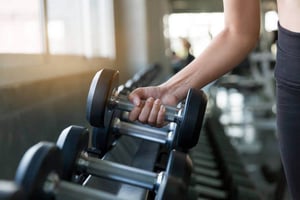In the world of gymnastics, strength, flexibility, and control are celebrated—but they also place...
Gymnasts' Guide to Injury Prevention: Protecting Your Back (Part 2)
Core Control, Spinal Stability, and Smart Recovery for Long-Term Performance
In Part 1, the main focus was on mobility along with exercises to utilize the new range of motion. Part 2 is where we will dive into core strength, spinal stability, and recovery strategies—the key pieces that support healthy gymnastics training and reduce the risk of back injuries.
At our performance physical therapy clinic in Wilmington, NC, we work with gymnasts of all levels who are pushing their bodies to the limit. And one thing is clear: a strong, stable spine is just as important as flexibility when it comes to keeping your back safe and your skills sharp.
Why Core Stability Matters for Gymnasts
In gymnastics, core strength isn’t just about six-pack abs—it’s about dynamic stability. Your core’s job is to protect your spine during explosive movements, landings, and transitions.
Without control at the center, even perfect mobility can fall apart under pressure.
Train Spinal Stability (Not Just Movement)
A common mistake we see is focusing too much on movement (like crunches or sit-ups) and not enough on control.
Here’s how to build true spinal stability:
Anti-Extension Core Work
These drills prevent excessive arching that comes from the lower back, a very common compensation in gymnasts. These exercises are a great STARTING point, but can (and should) be progressed as your endurance improves.
- Dead bugs (with rib-to-hip connection)
- Plank variations (forearm, side plank with reach)
- Tall kneeling Drills(adds anti-rotation) such as these halos
Pro tip: Focus on breathing into your ribs and keeping your pelvis in a neutral (canister) position to avoid dumping into your low back.

Anti-Rotation & Control
Gymnasts often rotate through their spine during twisting elements. Training control helps prevent shear stress.
- Bird dogs with slow tempo
- Pallof variations such as this hinged version
- Side bridge row
Recovery = Performance
Recovery is your secret weapon. Many back injuries we see in youth and competitive gymnasts in Wilmington, NC aren’t caused by one big incident—but by accumulated stress.
Here’s how to help your spine recover:
Hydration + Nutrition
Your spine (including your discs) relies on hydration! Make sure you're drinking enough water—especially after long training sessions. Check out this blog for more hydration tips!
Prioritize Sleep
Sleep is when your body repairs tissue and consolidates motor learning. Athletes should aim for 8–10 hours/night.
Daily Mobility + Downregulation
After hard training, don’t just collapse on the couch. Use these recovery strategies:
- 90/90 breathing with feet on wall (helps calm the nervous system and reset pelvic position)
- Gentle spinal decompression on a foam roller or over yoga blocks
- Walking or easy cycling to promote blood flow
When to See a Performance Physical Therapist
If you're noticing:
- Ongoing low back soreness after practice
- Pain with bridges, walkovers, or landings
- Trouble maintaining proper form despite good effort
…it might be time for an expert assessment.
The Takeaway
Mobility opens the door. Stability keeps it safe. Recovery helps you come back stronger!
By training all three—mobility, stability, and smart recovery—you’ll not only reduce your risk of back injury, but also improve your gymnastics performance long-term.
If you're a gymnast, coach, or parent in the Wilmington, NC area and want to learn more about how performance physical therapy can support your training, reach out—we’re here to help!
In good health,
Dr. Eliza Cohen
Performance Physical Therapist + Wellness Consultant
Wilmington, NC
Follow here for more performance and nutrition tips: @conquermovementpt @doctor_cohen14






Leave A Comment: